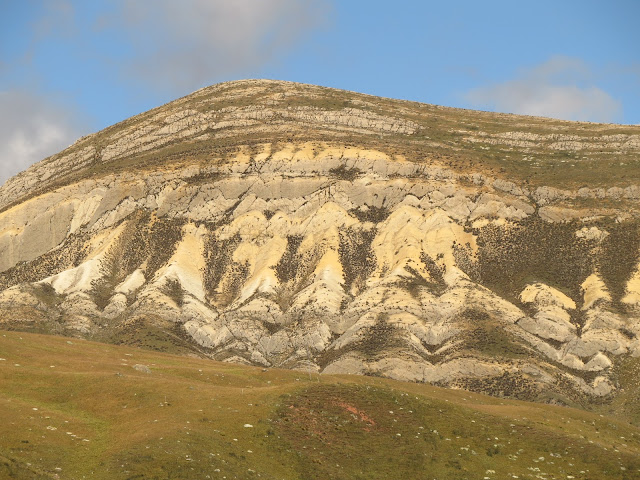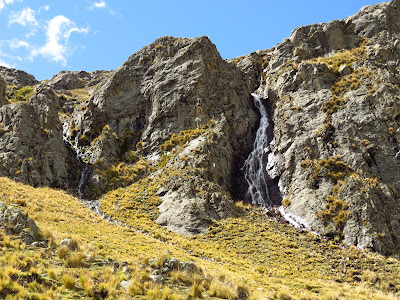May
1st,
2018
Cloudy
morning, light in my face breeze, showers with hail briefly in
afternoon, sunny intervals.
Goodbye
to Hose, Lee and family after breakfast, a pair of shorts, a t-shirt
and Manuel the cuddly toy pig for their toddler will lighten my load.
I had wanted to keep Manuel until Salvacion and give him as a prize
to one of the wonderful children of Chaskawasi-Manu but he has a
small split after the 'accident' the other day back at Huanza and
therefore I worry that the damage to him will increase if he stays on
the bike.
Elba,
the kind shop lady, who helped me on my arrival in the village the
other night, is walking with two friends and handshakes and cheek to
cheek kisses are embarrassing but nice. There is a bank of soil on
the hill opposite the laundry buildings and it is full of large hole.
Two holes have attendant Andean Flickers and another one sits on a
rock by the road and is totally unperturbed by my passing.
After
the brief push uphill from the village edge, the dirt road is all
downhill to the next road junction. I stop to watch a juvenile
Mountain Caracara fly over and land nearby. On looking more closely I
count twenty one Caracara in the area. I wonder what attracts them
here.
Turning
left, north, onto the next road I cycle downhill. What a thrill to be
actually cycling again but really with it being nearly all downhill
this is really 'just falling in style!' Around a few bends and on a
flat river plain stretching away into the distance are a number of
good-sized lagoons and on them Chilean Flamingos.
I stop to count them. Fifty three. There are also lots of Puna Ibis, Andean Coot, a few Giant Coot, Speckles Ducks, Moorhen, eighteen Andean Geese and four Black-crowned Night Herons.
I stop to count them. Fifty three. There are also lots of Puna Ibis, Andean Coot, a few Giant Coot, Speckles Ducks, Moorhen, eighteen Andean Geese and four Black-crowned Night Herons.
Continuing
down the valley there are flocks of Puna Ibis, one flock contains an almost completely white bird, a partial albino, yet Passerines are few.
An Andean Negrtio on the bog, a few White-winged and Cream-bellied
Cincloides with the occasional Peruvian Sierra finch, Plain-coloured
Seedeater and Bright-rumped Yellow Finch.
Past
an old checkpoint with attendant barking dogs and hanging meat over
the doorway, there are two fence posts with dessicated carcases of
young dogs. How bizarre. Another thing to ponder.
The
valley stretches out into a wide, grass-covered plain with large
enclosures with various domestic herds. Once more every bit of the
landscape, excepting the mountain rocky peaks, are over grazed and
the landscape takes on the appearance of The Pennines or mid-Wales.
There is even a limestone-layered hillside that looks like Malham
Tarn and Ingleborough.
Within the paddocks are herds of cattle. Outside are herds of cattle, sheep and the animals that prove I am in Peru not taking a road over Wensleydale, Llamas. Such fabulous animals, the males are huge and their movement is camel-like.
The herd has animals of all ages and colour combinations of brown, white and buff.
Within the paddocks are herds of cattle. Outside are herds of cattle, sheep and the animals that prove I am in Peru not taking a road over Wensleydale, Llamas. Such fabulous animals, the males are huge and their movement is camel-like.
The herd has animals of all ages and colour combinations of brown, white and buff.
One
anclosure of cows has around one hundred and fifty Andean Geese
behind them and they make a spectacular sight and sound as they take
off together with dozens of Puna Ibis.
There
are also large groups of horses. Six horses are being taken along the
road by two men with three dogs. An old-style lifestyle it may seem
but perfect for this environment. The one horseman has large bags
either side of the horse and they slowly progress along the road.
Now
I am a tad nervous of passing cows nowadays for the obvious reason.
Once battered twice shy! So when a herd of cattle approach me along
the road I carefully stand to one side and watch carefully as they
pass. They too seem nervous of me and the odd cow stands for a while
before running to get past. I am ready to get over the barbed wire
fence if any come closer than the other side of the road.
On
one bend in the road there is a small pool with seven Chilean
Flamingos. I stop to look closer and a herd of cows come down the
road but won't go any further with me being there. This time I do
climb over the fence and go to the other end of the road to where
they are and persuade them to move along. Luckily they do. Returning
to the pool and my bike I scan the pool and am delighted, no I am
totally surprised to find a Solitary
Sandpiper!
I had given no thought on this being available in the High Andes as a
bird for the trip, thinking that this beautiful wader would be in
North America by now. A bonus bird I feel that heightens moral.
There
are lots of pools in the area and checking them brings two Lesser
yellowlegs to go with the other Yank. There are also flocks of Puna
Ibis, a common bird in this habitat. Andean Negritos seem to like the
marshy edges as well for there are a few of them.
The
road splits once more and my way takes me along long stretches that
zig zag and gain height. On one bend three Puna
Snipe
dash out of the roadside ditch, calling as they, very much
snipe-like, fly low and disappear into the grass clumps and marsh
ground nearby. I try for half an hour or so to photograph and video
them with very limited success. Their call is very like that of the
European Common Snipe and the markings on mantle and wings likewise,
with mantle stripes and wingbars. About fifteen show themselves in
their usual low projectile fashion.
The
hill climb completed, there follows a very long, mile after mile slow
descent in rain and hail. A pale phase Variable Hawk sitting on a
fence post stops me. A shelter of a very basic sort helps me dry out
for a while and the rain stops within half an hour.
The descent continues on dirt track roads and another pale phase
Variable Hawk flies low in the valley below.
Around
a corner there is a junction where large lorries carrying mud and
pebbles have been joining the road. Here starts some serious road
works and the way is bumpy and wet, with mud clinging to the wheels.
I am stopped on one stretch as a lorry dumps it's load and a, what I
would call in Britain a JCB, flattens it all out ready for two
steamrollers, much larger than the ones I remember from my childhood
with two large tyres at one end and the metal roller at the other, to
finish the job.
After
being let through the road is extremely bumpy along long descending
stretches that have yet to be done. I am stopped again though by more
of the same sort of vehicles but the mud this time is far wetter than
before. No chance to cycle here, once let through I have to push.
Once
free again, the road goes down to a river and ascends the other side
where I find a confusing junction. My map tells me to go right so I
do. Two miles later I come across another, larger river and find
myself unable to get across because it is a three foot deep ford!
I contemplate fording it for about ten seconds with memories of the disaster of when I did so in February of 2015 in Devon. The ford on that occasion was flooded and my decision to try to cross, instead of returning and taking the ten mile diversion, ended up up with me waist deep in freezing water clinging onto the bike. Not this time thanks.
I contemplate fording it for about ten seconds with memories of the disaster of when I did so in February of 2015 in Devon. The ford on that occasion was flooded and my decision to try to cross, instead of returning and taking the ten mile diversion, ended up up with me waist deep in freezing water clinging onto the bike. Not this time thanks.
I
look down and think of how my panniers would cope if I did try to
cross. Panniers. One is missing. Front left. As I walk and cycle the
two miles back to the junction I try to think what was in it. I
suddenly panic and think that it is the one with my passport and
wallet in it! I get off and quickly look inside the one that is still
there. Thankfully my passport and wallet are in the one I still have.
Now that would have been a disaster. So what is in the one I have
lost. I work it out as I get nearer to the last junction I had seen
it. Socks, not too bad to lose. Toiletries, well I can get them at
the next village. A t-shirt, bugger, I liked that one and the bicycle
pump. Now losing that could be a problem obviously yet I have faith
in my Schwalbe Marathon tyres.
Having
not found it on reaching the junction I consider whether I had really
seen it there. Maybe it had fallen off on that very long, bumpy
descent. The thought of walking all the way back up there didn't
thrill me. Also it is by now only an hour before dark. I decide that
it is gone and walk the five kilometres to the next village. No
hostel here so I camp in a field having tried to get to the next
village, Santa Barbara, before dark but not making it. Setting the
tent up in the dark is fun.
Green
Year list : 184 birds
average new birds to list per day : 5.94 birds
average new birds to list per day : 5.94 birds
Distance
cycled : 33.78 miles
elevation
: up 1.862 feet, down 2,994 feet
altitude
: 13,356 feet




































